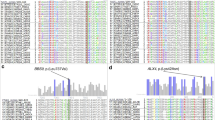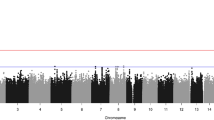Abstract
Lambdoid craniosynostosis (CS) is a congenital anomaly resulting from premature fusion of the cranial suture between the parietal and occipital bones. Predominantly sporadic, it is the rarest form of CS and its genetic etiology is largely unexplored. Exome sequencing of 25 kindreds, including 18 parent–offspring trios with sporadic lambdoid CS, revealed a marked excess of damaging (predominantly missense) de novo mutations that account for ~ 40% of sporadic cases. These mutations clustered in the BMP signaling cascade (P = 1.6 × 10–7), including mutations in genes encoding BMP receptors (ACVRL1 and ACVR2A), transcription factors (SOX11, FOXO1) and a transcriptional co-repressor (IFRD1), none of which have been implicated in other forms of CS. These missense mutations are at residues critical for substrate or target sequence recognition and many are inferred to cause genetic gain-of-function. Additionally, mutations in transcription factor NFIX were implicated in syndromic craniosynostosis affecting diverse sutures. Single cell RNA sequencing analysis of the mouse lambdoid suture identified enrichment of mutations in osteoblast precursors (P = 1.6 × 10−6), implicating perturbations in the balance between proliferation and differentiation of osteoprogenitor cells in lambdoid CS. The results contribute to the growing knowledge of the genetics of CS, have implications for genetic counseling, and further elucidate the molecular etiology of premature suture fusion.




Similar content being viewed by others
Data availability
The sequences for case-parent trios reported in the paper have been deposited in the NCBI database of Genotypes and Phenotypes (dbGaP) under accession phs000744.
References
Adam RC et al (2020) NFI transcription factors provide chromatin access to maintain stem cell identity while preventing unintended lineage fate choices. Nat Cell Biol 22(6):640–650
Boyden LM et al (2002) High bone density due to a mutation in LDL-receptor-related protein 5. N Engl J Med 346(20):1513–1521
Calpena E et al (2021) Unexpected role of SIX1 variants in craniosynostosis: expanding the phenotype of SIX1-related disorders. J Med Genet 59:165–169
Cheng Z et al (2011) Crystal structures of the extracellular domain of LRP6 and its complex with DKK1. Nat Struct Mol Biol 18(11):1204–1210
Farmer DT et al (2021) The developing mouse coronal suture at single-cell resolution. Nat Commun 12(1):4797
Flaherty K, Singh N, Richtsmeier JT (2016) Understanding craniosynostosis as a growth disorder. Wiley Interdiscip Rev Dev Biol 5:429–459
Gadi J et al (2013) The transcription factor protein Sox11 enhances early osteoblast differentiation by facilitating proliferation and the survival of mesenchymal and osteoblast progenitors. J Biol Chem 288(35):25400–25413
Glass GE et al (2019) ERF-related craniosynostosis: The phenotypic and developmental profile of a new craniosynostosis syndrome. Am J Med Genet A 179(4):615–627
Gurrieri F et al (2015) NFIX mutations affecting the DNA-binding domain cause a peculiar overgrowth syndrome (Malan syndrome): a new patients series. Eur J Med Genet 58(9):488–491
Hafemeister C, Satija R (2019) Normalization and variance stabilization of single-cell RNA-seq data using regularized negative binomial regression. Genome Biol 20(1):296
Hao Y et al (2021) Integrated analysis of multimodal single-cell data. Cell 184(13):3573-3587 e29
Holmes G et al (2020) Integrated transcriptome and network analysis reveals spatiotemporal dynamics of calvarial suturogenesis. Cell Rep 32(1):107871
Hou C et al (2020) Structural insight into the DNA binding function of transcription factor ERF. Biochemistry 59:4499–4506
Jonker L (2014) TGF-beta & BMP receptors endoglin and ALK1: overview of their functional role and status as antiangiogenic targets. Microcirculation 21(2):93–103
Jumper J et al (2021) Highly accurate protein structure prediction with AlphaFold. Nature 596:583–589
Kwee ML et al (2005) An autosomal dominant high bone mass phenotype in association with craniosynostosis in an extended family is caused by an LRP5 missense mutation. J Bone Miner Res 20(7):1254–1260
Malan V et al (2010) Distinct effects of allelic NFIX mutations on nonsense-mediated mRNA decay engender either a Sotos-like or a Marshall-Smith syndrome. Am J Hum Genet 87(2):189–198
Maruyama T et al (2021) BMPR1A maintains skeletal stem cell properties in craniofacial development and craniosynostosis. Sci Transl Med 13:583
McDonald J et al (2011) Molecular diagnosis in hereditary hemorrhagic telangiectasia: findings in a series tested simultaneously by sequencing and deletion/duplication analysis. Clin Genet 79(4):335–344
Onishi Y et al (2017) The transcriptional modulator Ifrd1 is a negative regulator of BMP-2-dependent osteoblastogenesis. Biochem Biophys Res Commun 482(2):329–334
Patel A et al (2014) The impact of age at surgery on long-term neuropsychological outcomes in sagittal craniosynostosis. Plast Reconstr Surg 134(4):608e-e617
Ramasamy SK et al (2014) Endothelial Notch activity promotes angiogenesis and osteogenesis in bone. Nature 507(7492):376–380
Rindone AN et al (2021) Quantitative 3D imaging of the cranial microvascular environment at single-cell resolution. Nat Commun 12(1):6219
Sharma VP et al (2013) Mutations in TCF12, encoding a basic helix-loop-helix partner of TWIST1, are a frequent cause of coronal craniosynostosis. Nat Genet 45(3):304–307
Shi Y et al (1998) Crystal structure of a Smad MH1 domain bound to DNA: insights on DNA binding in TGF-beta signaling. Cell 94(5):585–594
Stefancsik R, Sarkar S (2003) Relationship between the DNA binding domains of SMAD and NFI/CTF transcription factors defines a new superfamily of genes. DNA Seq 14(4):233–239
Teixeira CC et al (2010) Foxo1, a novel regulator of osteoblast differentiation and skeletogenesis. J Biol Chem 285(40):31055–31065
Timberlake AT, Persing JA (2018) Genetics of nonsyndromic craniosynostosis. Plast Reconstr Surg 141(6):1508–1516
Timberlake AT et al (2016) Two locus inheritance of non-syndromic midline craniosynostosis via rare SMAD6 and common BMP2 alleles. Elife. https://doi.org/10.7554/eLife.20125
Timberlake AT et al (2017) De novo mutations in inhibitors of Wnt, BMP, and Ras/ERK signaling pathways in non-syndromic midline craniosynostosis. Proc Natl Acad Sci USA 114(35):E7341–E7347. https://doi.org/10.1073/pnas.1709255114
Timberlake AT et al (2019) Mutations in TFAP2B and previously unimplicated genes of the BMP, Wnt, and Hedgehog pathways in syndromic craniosynostosis. Proc Natl Acad Sci USA 116(30):15116–15121
Tonne E et al (2021) Benefits of clinical criteria and high-throughput sequencing for diagnosing children with syndromic craniosynostosis. Eur J Hum Genet 29(6):920–929
Twigg SR, Wilkie AO (2015) A genetic-pathophysiological framework for craniosynostosis. Am J Hum Genet 97(3):359–377
Twigg SR et al (2013) Reduced dosage of ERF causes complex craniosynostosis in humans and mice and links ERK1/2 signaling to regulation of osteogenesis. Nat Genet 45(3):308–313
Ware JS et al (2015) Interpreting de novo variation in human disease using denovolyzeR. Curr Protoc Hum Genet 87:7 25 1-7 25 15
Wei Q et al (2015) A Bayesian framework for de novo mutation calling in parents-offspring trios. Bioinformatics 31(9):1375–1381
Wilk K et al (2017) Postnatal calvarial skeletal stem cells expressing PRX1 reside exclusively in the calvarial sutures and are required for bone regeneration. Stem Cell Rep 8(4):933–946
Acknowledgements
This project was supported by the Yale Center for Mendelian Genomics (NIH Grant M#UM1HG006504-05). This study makes use of data generated by the DECIPHER community. A full list of centres who contributed to the generation of the data is available from https://decipher.sanger.ac.uk and via email from decipher@sanger.ac.uk. Funding for the DECIPHER project was provided by Wellcome.
Author information
Authors and Affiliations
Consortia
Contributions
ATT; conceptualization, formal analysis, investigation, writing—original draft, writing—review and editing, EK; investigation; SCJ; investigation, CNW; project administration, investigation, EL; project administration, investigation, Yale Center for Genome Analysis; project administration, AA; visualization, AA; visualization, SB; investigation, HS.; investigation, MRPB; investigation, RR; investigation, SRR; investigation, ET; investigation, ALS; investigation, TJB; investigation, MA, investigation; DS; investigation, DAS; investigation; RLF; investigation, JAP; investigation, KTK, investigation, writing; RPL, conceptualization, project administration, funding acquisition, writing—original draft, writing—review and editing.
Corresponding authors
Ethics declarations
Conflict of interest
No authors report any conflicts of interest.
Ethical approval
The study protocol was approved by the Yale Human Investigation Committee’s Institutional Review Board. Patients and family members provided written consent for inclusion of clinical photographs obtained from the family directly or referring clinicians.
Additional information
Publisher's Note
Springer Nature remains neutral with regard to jurisdictional claims in published maps and institutional affiliations.
Supplementary Information
Below is the link to the electronic supplementary material.
Rights and permissions
Springer Nature or its licensor holds exclusive rights to this article under a publishing agreement with the author(s) or other rightsholder(s); author self-archiving of the accepted manuscript version of this article is solely governed by the terms of such publishing agreement and applicable law.
About this article
Cite this article
Timberlake, A.T., Kiziltug, E., Jin, S.C. et al. De novo mutations in the BMP signaling pathway in lambdoid craniosynostosis. Hum Genet 142, 21–32 (2023). https://doi.org/10.1007/s00439-022-02477-2
Received:
Accepted:
Published:
Issue Date:
DOI: https://doi.org/10.1007/s00439-022-02477-2




